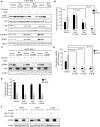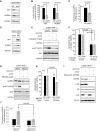Therapeutically actionable signaling node to rescue AURKA driven loss of primary cilia in VHL-deficient cells
- PMID: 34002003
- PMCID: PMC8128866
- DOI: 10.1038/s41598-021-89933-7
Therapeutically actionable signaling node to rescue AURKA driven loss of primary cilia in VHL-deficient cells
Erratum in
-
Author Correction: Therapeutically actionable signaling node to rescue AURKA driven loss of primary cilia in VHL-deficient cells.Sci Rep. 2021 Aug 30;11(1):17657. doi: 10.1038/s41598-021-97270-y. Sci Rep. 2021. PMID: 34462545 Free PMC article. No abstract available.
Abstract
Loss of primary cilia in cells deficient for the tumor suppressor von Hippel Lindau (VHL) arise from elevated Aurora Kinase A (AURKA) levels. VHL in its role as an E3 ubiquitin ligase targets AURKA for degradation and in the absence of VHL, high levels of AURKA result in destabilization of the primary cilium. We identified NVP-BEZ235, a dual PI3K/AKT and mTOR inhibitor, in an image-based high throughput screen, as a small molecule that restored primary cilia in VHL-deficient cells. We identified the ability of AKT to modulate AURKA expression at the transcript and protein level. Independent modulation of AKT and mTOR signaling decreased AURKA expression in cells confirming AURKA as a new signaling node downstream of the PI3K cascade. Corroborating these data, a genetic knockdown of AKT in cells deficient for VHL rescued the ability of these cells to ciliate. Finally, inhibition of AKT/mTOR using NVP-BEZ235 was efficacious in reducing tumor burden in a 786-0 xenograft model of renal cell carcinoma. These data highlight a previously unappreciated signaling node downstream of the AKT/mTOR pathway via AURKA that can be targeted in VHL-null cells to restore ciliogenesis.
Conflict of interest statement
The authors declare no competing interests.
Figures





Similar articles
-
β-catenin links von Hippel-Lindau to aurora kinase A and loss of primary cilia in renal cell carcinoma.J Am Soc Nephrol. 2015 Mar;26(3):553-64. doi: 10.1681/ASN.2013090984. Epub 2014 Oct 13. J Am Soc Nephrol. 2015. PMID: 25313256 Free PMC article.
-
Bexarotene - a novel modulator of AURKA and the primary cilium in VHL-deficient cells.J Cell Sci. 2018 Dec 14;131(24):jcs219923. doi: 10.1242/jcs.219923. J Cell Sci. 2018. PMID: 30518623 Free PMC article.
-
Inhibition of autophagy enhances apoptosis induced by the PI3K/AKT/mTor inhibitor NVP-BEZ235 in renal cell carcinoma cells.Cell Biochem Funct. 2013 Jul;31(5):427-33. doi: 10.1002/cbf.2917. Epub 2012 Oct 22. Cell Biochem Funct. 2013. PMID: 23086777
-
Significance of PI3K signalling pathway in clear cell renal cell carcinoma in relation to VHL and HIF status.J Clin Pathol. 2021 Apr;74(4):216-222. doi: 10.1136/jclinpath-2020-206693. Epub 2020 May 28. J Clin Pathol. 2021. PMID: 32467322 Review.
-
PI3K/AKT/mTOR Dysregulation and Reprogramming Metabolic Pathways in Renal Cancer: Crosstalk with the VHL/HIF Axis.Int J Mol Sci. 2023 May 7;24(9):8391. doi: 10.3390/ijms24098391. Int J Mol Sci. 2023. PMID: 37176098 Free PMC article. Review.
Cited by
-
Primary cilia and actin regulatory pathways in renal ciliopathies.Front Nephrol. 2024 Jan 16;3:1331847. doi: 10.3389/fneph.2023.1331847. eCollection 2023. Front Nephrol. 2024. PMID: 38292052 Free PMC article. Review.
-
Recent advances in the understanding of cilia mechanisms and their applications as therapeutic targets.Front Mol Biosci. 2023 Sep 14;10:1232188. doi: 10.3389/fmolb.2023.1232188. eCollection 2023. Front Mol Biosci. 2023. PMID: 37780208 Free PMC article. Review.
-
Aurora A and AKT Kinase Signaling Associated with Primary Cilia.Cells. 2021 Dec 20;10(12):3602. doi: 10.3390/cells10123602. Cells. 2021. PMID: 34944109 Free PMC article. Review.
-
Islet cilia and glucose homeostasis.Front Cell Dev Biol. 2022 Dec 1;10:1082193. doi: 10.3389/fcell.2022.1082193. eCollection 2022. Front Cell Dev Biol. 2022. PMID: 36531945 Free PMC article. Review.
References
Publication types
MeSH terms
Substances
Grants and funding
LinkOut - more resources
Full Text Sources
Other Literature Sources
Medical
Miscellaneous

